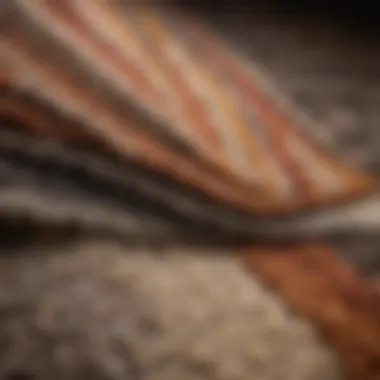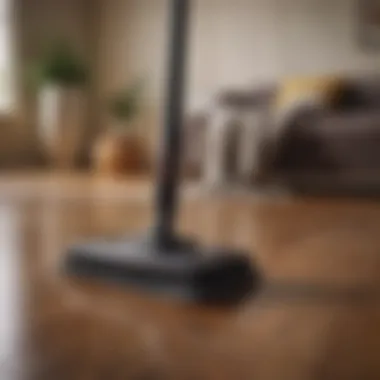A Comprehensive Guide to Washing Area Rugs Effectively


Intro
Washing area rugs is a task that often seems trivial, yet it holds immense significance in maintaining the aesthetic and hygiene of a living space. Rugs not only enhance the decor but also contribute to the comfort of a home. However, many homeowners are unsure about the proper ways to wash and care for their rugs, particularly due to the variety of materials and intricate designs available in the market today. This article seeks to clarify the process, offering a comprehensive understanding of how to wash area rugs without compromising their integrity.
In the sections to come, we will discuss key preparations before washing, explore tailored cleaning techniques based on rug materials, elaborate on appropriate drying methods, and provide maintenance tips that ensure rugs remain in excellent condition. Engaging in this topic is crucial for homeowners as it facilitates better care practices and enhances the longevity of their decorative investments.
Understanding Area Rugs
Area rugs serve not only as decorative elements in a home but also fulfill functional roles. They define spaces, add warmth, and offer comfort. Understanding the different types of area rugs available and the importance of maintaining their cleanliness is essential. This knowledge can improve interior design choices and enhance a home's ambiance.
Types of Area Rugs
Natural Fiber Rugs
Natural fiber rugs, made from materials like jute, sisal, and seagrass, are appreciated for their eco-friendly properties. They breathe well and often add a rustic touch to interiors. Their unique feature lies in their sustainability. However, they can absorb moisture and may not be the best choice for high-traffic areas. Their natural look contributes to a serene environment but may require frequent cleaning to prevent dirt build-up.
Synthetic Fiber Rugs
Synthetic fiber rugs, made from materials like nylon, polypropylene, or polyester, are known for durability and stain resistance. They are often easier to clean than natural fibers and come in a wide range of designs. The affordability of synthetic rugs makes them a popular choice. However, they may not provide the same aesthetic richness as natural options and can be less breathable, which could lead to odors.
Wool Rugs
Wool rugs are highly valued for their softness and warmth. They resist stains and are durable, holding up well under heavy foot traffic. Wool has natural insulating properties. An important consideration is that they can be more expensive than other options. Their unique ability to regulate temperature can enhance comfort, but they may require professional cleaning due to sensitivity to water and harsh chemicals.
Silk Rugs
Silk rugs offer unmatched luxury and elegance. Their luminous finish and intricate patterns make them a favorite among design enthusiasts. They are soft and can elevate the aesthetic appeal of any room. However, silk rugs are delicate and not ideal for households with pets or children. They require careful handling and specific cleaning methods to maintain their appearance.
Cotton Rugs
Cotton rugs are versatile and easy to clean, often machine-washable. They are soft underfoot and available in a variety of colors and patterns, making them an excellent choice for casual spaces. Despite their affordability and ease of care, cotton rugs may not be as durable as wool or synthetic options. They can stain easily if not maintained properly, requiring regular washing to keep them looking fresh.
The Importance of Cleaning Rugs
Cleaning area rugs is vital for several reasons, impacting health, aesthetics, and longevity.
Preventing Allergies
Regular cleaning of area rugs can significantly reduce allergens such as dust mites, pet dander, and pollen. These allergens can accumulate in fibers, causing respiratory issues and allergies. A well-maintained rug promotes a healthier living environment.
Extending Lifespan
Regular cleaning practices can prolong the life of an area rug. Dirt and debris can wear down fibers over time. By maintaining a cleaning schedule, one can prevent irreversible damage and maintain the rug's integrity. An investment in cleaning can translate to significant savings in the long run.
Maintaining Aesthetic Appeal
A clean area rug enhances the overall aesthetic of the home. Stains and dirt can detract from the design and ambiance of a space. Clean rugs bolster the decor and contribute to a polished look. Regular maintenance helps in preserving color vibrancy and texture.
Preparation for Cleaning
Preparation is a crucial step when it comes to washing area rugs effectively. Taking the time to prepare can significantly enhance the cleaning process and ultimately leads to better outcomes. Working without proper preparation can cause damage to the rug or lead to ineffective cleaning. Understanding the rug's condition and materials, as well as gathering the right supplies, can streamline the entire process. This not only protects the integrity of the fabric but also ensures that the rug remains an appealing part of your interior design.
Assessing Rug Condition


Checking for Damage
When preparing to clean an area rug, checking for damage is an essential first step. Identifying any wear and tear can prevent further harm during cleaning. Look for areas that may be fraying, holes, or loose threads. This aspect is vital as cleaning a damaged rug may exacerbate the issues, potentially leading to irreversible problems. A key characteristic of inspecting for damage is the awareness it promotes regarding the rug’s current state. By being proactive, you can decide if professional cleaning is necessary. While checking for damage, one must be careful not to overlook subtle signs. Little issues can escalate if ignored. Thus, it is beneficial to take immediate action if any problems are discovered.
Inspecting for Stains
Inspecting for stains is another critical step in the preparation phase. Stains can be the most conspicuous issue and they require prompt attention. Different types of stains, such as food or pet-related stains, might necessitate different cleaning approaches. Spotlighting this step ensures you focus your efforts on the most problematic areas. This stage is helpful because it allows you to tailor the cleaning process to specific challenges your rug presents. However, it can be time-consuming if numerous stains are present. Understanding the types of stains and their origins can inform the choice of cleaning solutions needed.
Identifying Material Type
Identifying the material type is fundamental when preparing to clean an area rug. Different materials respond differently to cleaning agents and techniques. For instance, rugs made from delicate fabrics like silk require gentler methods, while synthetic rugs may withstand harsher treatments. This knowledge informs your approach and helps to select the appropriate cleaning products. Understanding the unique features of various materials can prevent damage during cleaning. Additionally, knowing each material's benefits and disadvantages allows homeowners to make informed decisions about routine care and maintenance.
Gathering Necessary Supplies
Vacuum Cleaner
A vacuum cleaner is one of the most vital tools for rug maintenance. Regular vacuuming removes dirt and dust, which can build up and become embedded in the fibers. High-quality vacuum cleaners can deep clean without causing harm. Selecting a model with adjustable settings allows you to adapt to different rug types. A good vacuum cleaner has a big advantage—it can prolong the time between deep cleanings. Long-term use helps maintain both the appearance and health of the rug. However, not all vacuum cleaners are suitable for every rug; choosing one that's appropriate is essential.
Mild Detergent
Mild detergent is a key ingredient for effective cleaning. This type of detergent is less likely to damage fibers and colors, making it a safe choice for most rugs. It provides sufficient cleaning power without being overly harsh. A common benefit of using mild detergent is its ability to effectively break down dirt without leaving residues that could attract more dirt later. While it is a popular choice for general cleaning, some stains may require specialized solutions for complete removal.
Soft Brush
Using a soft brush is highly recommended during the cleaning process. A soft brush can gently lift dirt without damaging delicate fibers, making it a beneficial tool for textured rugs. This feature stands out, as rough-bristled brushes can cause fraying or other damage. Additionally, a soft brush allows you to clean in smaller sections effectively, ensuring comprehensive treatment. However, care should be taken not to apply too much pressure while brushing, as this could lead to wear over time.
Water Bucket
A water bucket is a practical supply for washing rugs. It provides a designated space for mixing cleaning agents and rinsing. An important characteristic of using a water bucket is its convenience; it ensures you have ready access to water, which is essential when using wet cleaning methods. Furthermore, using a bucket allows for controlled water application, which is critical to prevent oversaturating the rug. However, you must be careful to not use too much water during the cleaning process, as this can lead to moisture retention and potential mold growth.
Drying Towels
Drying towels play a significant role in the cleaning process. They help to absorb excess moisture after washing, minimizing the risk of damage. The key characteristic of drying towels is their absorbent quality; using highly absorbent towels can drastically reduce drying time. A set of good drying towels enables an efficient cleanup, allowing the rug to dry faster. On the downside, using towels that aren't absorbent may prolong drying, which is not ideal. It's always best to prepare a couple of good quality towels in advance.
Prioritizing these preparations will equipped you to clean your area rugs more effectively and safely.
Cleaning Techniques
Cleaning techniques are essential for maintaining area rugs in optimal condition. They ensure that dirt, dust, and allergens are effectively removed while preserving the integrity of the rug's materials. Proper cleaning techniques not only enhance the aesthetic appeal but also contribute to a healthier living environment. Understanding various cleaning methods can help homeowners extend the lifespan of their rugs, reduce the need for frequent replacements, and ultimately save money.
Vacuuming the Rug
Using the Right Settings
Using the right settings on a vacuum cleaner is crucial when cleaning area rugs. Many vacuum cleaners have adjustable settings tailored for different surfaces. For example, a higher suction power may be suitable for carpets, while a lower setting is better for delicate area rugs. Utilizing the appropriate setting prevents potential damage to the fibers while ensuring effective dirt removal. A vacuum equipped with a beater bar should generally be avoided on delicate rugs, as this can lead to fraying. Importantly, adjusting the settings helps maintain the rug’s texture and appearance over time.
Technique to Avoid Damage
When vacuuming an area rug, employing a technique to avoid damage is imperative. One effective method is to vacuum in the direction of the pile. This technique minimizes the wear and tear on the fibers and prevents entanglement in the vacuum's brush. Additionally, it's important to avoid vacuuming over loose edges or corners, which can be easily damaged. By taking these precautions, the vacuuming process becomes safe and efficient, preserving the rug's quality.
Frequency of Vacuuming
Determining the frequency of vacuuming is key to maintaining clean area rugs. Generally, rugs in high-traffic areas should be vacuumed at least once a week. However, the frequency can vary based on usage and the presence of pets or allergies. Regular vacuuming removes surface dirt and dust that can accumulate, preventing deeper stains from developing. Adapting the vacuuming routine according to the rug’s environment ensures that it stays looking fresh without more intensive cleanings.
Spot Cleaning Stains


Immediate Response to Stains
Immediate response to stains is critical for effective spot cleaning. When a spill occurs, swift action can prevent the stain from setting in. Blotting the area gently with a clean cloth or paper towel is advised. This technique absorbs excess liquid without spreading the stain. Prompt attention keeps the rug pristine and reduces the likelihood of lasting damage. Ignoring a stain can lead to deeper penetration within the fibers, making it much more difficult to remove later.
Suction Techniques for Liquid Stains
Suction techniques for liquid stains play a vital role in minimizing damage. Using a wet/dry vacuum or a carpet cleaner with suction capabilities can effectively remove liquid spills. By applying suction, one can draw out the liquid before it seeps into the backing of the rug. This method is particularly effective for larger spills. However, it is essential to operate the vacuum correctly to avoid over-saturating the rug, which can lead to mold growth.
Applying Cleaning Solutions
Applying cleaning solutions is another fundamental aspect of spot cleaning. Once the initial blotting is done, choosing an appropriate cleaning solution designed for the rug's material is vital. A mild soap or specialized cleaner should be mixed with water per product instructions. Applying it carefully with a soft cloth assists in removing the stain while ensuring no harsh chemicals compromise the fibers. Always testing the solution in a hidden area first ensures that it does not cause discoloration.
Deep Cleaning Methods
Water Submersion Technique
The water submersion technique is suitable for certain types of rugs. This method involves soaking the rug in a tub of lukewarm water mixed with a detergent. It is particularly useful for directional cleaning when the rug is heavily soiled. This technique can thoroughly clean both the fibers and the backing. However, caution is necessary, as water can damage some materials, particularly those that are sensitive to moisture.
Shampooing the Rug
Shampooing the rug helps in deep cleaning while also rejuvenating the material. A specialized carpet shampoo, mixed with water, is applied using a brush or machine designed for this purpose. Shampooing can remove deeper stains that regular cleaning may miss. However, ensuring that the rug is thoroughly rinsed afterward is vital to prevent residue from accumulating, which can lead to dirt attraction.
Using a Professional Cleaner
Considering the option of using a professional cleaner is wise for rugs requiring more thorough care. Professionals possess the appropriate equipment, expertise, and cleaning solutions for various types of rugs. Outsourcing to a professional also saves time and often yields better results than DIY methods. However, this option may incur a higher cost and should be factored into the rug maintenance budget.
Drying and Post-Cleaning Care
The importance of drying and post-cleaning care cannot be overstated. Properly drying area rugs after washing safeguards their structural integrity and appearance. Rugs that remain damp can develop mildew, leading to foul odors and potential fabric damage. Immediate attention to drying preserves the investment in your decor, ensuring that your rugs not only look good but last longer.
Proper Drying Techniques
Avoiding Direct Sunlight
Avoiding direct sunlight is vital when drying area rugs. Prolonged exposure to sun can fade colors and weaken fibers. Sunlight, while effective for drying, alters the dye composition and may lead to uneven discoloration. Therefore, it is a beneficial choice for preserving the rug’s vibrancy. Keeping rugs in the shade or indoors allows them to dry without risking damage.
Using Fans for Airflow
Using fans for airflow improves drying efficiency. The breeze created by fans circulates air, reducing humidity around the rug. This technique speeds up the drying process, minimizing time spent in a damp environment. It is a widely recommended method in rug care due to its simplicity and effectiveness. However, it is essential to position fans correctly to avoid blowing dust and debris onto the rug's surface.
Checking for Moisture
Checking for moisture ensures that rugs are thoroughly dry before reinstallation. Damp areas in rugs can promote mold growth and bug infestations. Regularly checking moisture levels safeguards your rug’s quality and prevents potential damage. This step is crucial for confirming that the drying techniques employed have been successful.
Reassembling and Finishing Touches
Placing Rugs Back in Position
Carefully placing rugs back in position allows you to preserve their intended look and functionality. This specific aspect is key because misplacement can lead to uneven wear and tear over time. Ensuring proper alignment with furniture and decor enhances both the aesthetics and durability of the rug. It is a wise choice for maintaining the harmony of your living space.
Brushing the Rug Pile
Brushing the rug pile restores the fibers to their original position and shape. This method is beneficial as it eliminates any lingering dirt and enhances the overall appearance. By using a soft brush, you encourage the fibers to stand upright, creating a plush feel underfoot. This helps preserve the rug's quality and ensure it looks its best.


Inspecting for Any Remaining Stains
Inspecting for any remaining stains is crucial for how the rug will maintain its appeal. Even after cleaning, some stains may not vanish completely. A thorough inspection allows prompt action against any stubborn marks. This diligence can save you time and effort in the long run, keeping your rug in pristine condition.
"Proper drying and post-cleaning care are integral to the longevity and beauty of area rugs."
Ongoing Maintenance
Ongoing maintenance is critical in ensuring the longevity and aesthetic appeal of area rugs. Many homeowners underestimate the significance of regular upkeep, often waiting until visible dirt or damage occurs. Regular care prevents deeper issues from developing. It creates an environment where rugs can be enjoyed for years.
Routine Cleaning Practices
Regular Vacuuming Schedule
One of the most important aspects of rug maintenance is establishing a regular vacuuming schedule. This practice removes dust, dirt, and allergens from the surface before they settle deeper into the fibers. In general, it is advisable to vacuum area rugs at least once a week, and more often in high-traffic areas. Key characteristic of a regular schedule is its ability to reduce wear and tear on the rug fibers, making this a beneficial choice for maintaining area rugs.
Regular vacuuming directly contributes to the overall cleanliness of your home. It is inexpensive and requires little time. However, improper vacuuming can cause damage. Ensure your vacuum has the right settings and brushes designed for the rug type. This careful attention prevents fraying or pulling of fibers.
Periodic Deep Cleaning
Another essential aspect of rug care is periodic deep cleaning. Depending on the rug material and usage, deep cleaning is recommended every six months to a year. This process eliminates stubborn stains and accumulated dirt, resetting the rug's appearance. It's beneficial because it fully refreshes the fibers, restoring vibrancy and texture.
Periodic deep cleaning involves techniques like water submersion or professional cleaning services. Each method has its unique benefit. However, it requires extra time and preparation. Homeowners must assess their rug materials carefully, ensuring the chosen method is safe and effective.
Rotating the Rug
Rotating the rug is often overlooked in maintenance routines. It ensures even wear, especially in rooms with furniture that creates pressure points. By adjusting the direction, homeowners can prevent fading and tracking on one side while maintaining an appealing look. The key characteristic lies in its simplicity. This practice is straightforward yet significantly prolongs the rug’s life.
While rotating may seem trivial, its impact is substantial. Homeowners should aim to rotate rugs every few months. This small habit prevents unattractive marks and increases overall durability. Still, it requires effort to remember to do it regularly.
Storage and Care Tips
How to Store Rugs Properly
Proper storage of rugs is critical during long periods of non-use. Storing rugs incorrectly can lead to creasing, mold, or hardening of fibers. The correct method includes rolling the rug tightly and storing it in a cool, dry place. This practice prevents moisture accumulation, which can damage the material. By ensuring that rugs are free of dust and securely placed, homeowners can protect their investment.
Proper storage may require a specific kind of space, free from damp conditions. It’s beneficial for homeowners who frequently change seasonal decor or move. However, the effort needed for thorough cleaning and rolling can be labor-intensive.
Avoiding Damp Environments
Avoiding damp environments is another crucial aspect of rug care. High humidity can lead to mold and mildew, deteriorating the appearance and integrity of rugs. Maintaning a dry space also enhances indoor air quality, reducing allergens and potential health issues.
It is particularly applicable in basements or areas prone to moisture. Using dehumidifiers can counterbalance this problem. This focus on a dry environment contributes to the longevity of area rugs. However, actively monitoring moisture levels can seem daunting for some homeowners.
Using Protective Covers
Using protective covers is a practical step in safeguarding rugs from dirt and wear. Whether it is a transparent plastic cover or breathable fabric, this protective layer can shield against spills and foot traffic. This method often proves to be beneficial in high-traffic areas, such as living rooms.
Protective covers offer an effective barrier during specific occasions, such as parties or family gatherings. The unique feature here is adaptability; homeowners can choose when to cover the rugs based on needs. However, it does add an extra step in the appearance of the home, as some may find coverings unattractive or cumbersome to manage.
Culmination
In the realm of home care, understanding how to maintain area rugs is essential. This article encapsulates the nuances of caring for these stylish and functional accents. Each section outlines methods that protect the fabric while ensuring cleanliness and prolonging the lifespan of the rug. By grasping the significance of thorough cleaning, homeowners can prevent allergies, extend the life of their investment, and maintain the visual appeal of their living spaces.
Final Thoughts on Rug Care
Taking care of area rugs goes beyond mere cleaning; it involves a commitment to preserving the quality and aesthetic of the piece. Regular maintenance ensures the rug remains a beautiful element in any room. This includes not just washing techniques but also understanding the appropriate methods based on material type.
- Develop a routine: Establish regular vacuuming schedules and periodic deep cleans to avoid dirt accumulation.
- Careful storage: When storing rugs, opt for dry environments and consider protective coverings to guard against dust and insects.
- Immediate action on stains: Address stains promptly to prevent them from becoming embedded in the fibers.
Furthermore, the joy derived from a well-maintained rug contributes to the overall ambiance of a home. In essence, prioritizing rug care is an investment in the home environment, enhancing both comfort and style. By following the practices shared in this guide, individuals can confidently approach rug cleaning, ensuring their spaces remain both functional and attractive.





